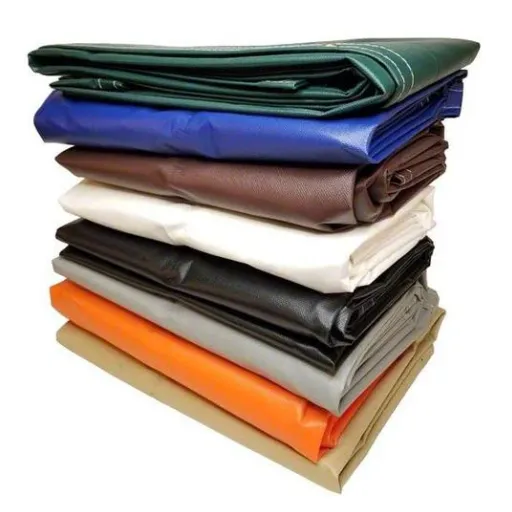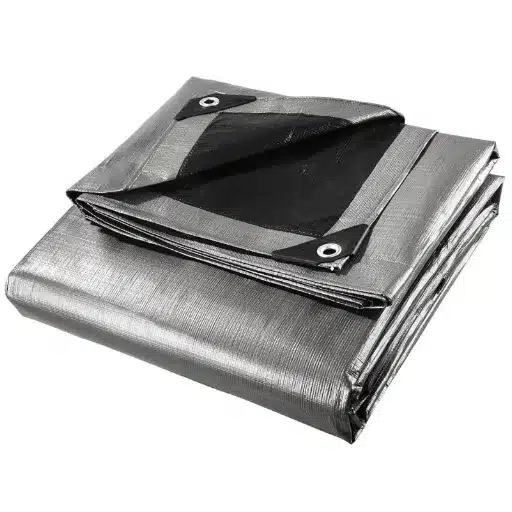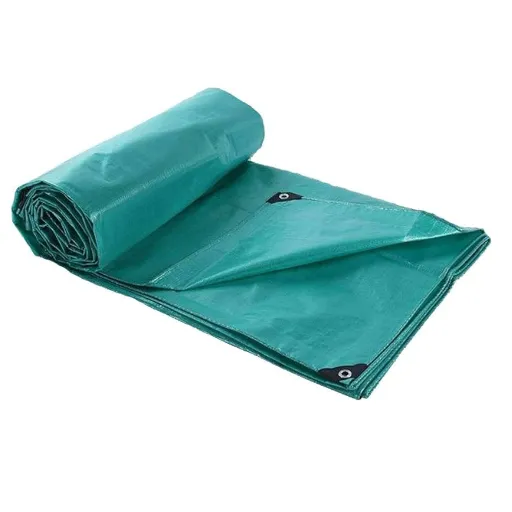Heavy duty tarps provide a very basic protection for precious equipment, cargo, and materials in setting environments where industrial and transportation activities take place. Designed for toughness and utility, these commercial-grade tarps are made to withstand the rigors of harsh conditions such as extreme weather, abrasive surfaces, and harsh local exposure. Sometimes a logistics worker would secure a load on a flatbed truck, and at other times an industrial operator would protect the machinery in an outdoor environment. In both instances, the right tarp plays a big role in ensuring protection, safety, compliance, and cost efficiency. Herein, we will analyze and offer insights into the key features, applications, and benefits of heavy duty tarps in order to guide you toward identifying the best solution to your commercial requirements. Stay with us while we dissect what makes these tarps one of the most needed tools in industrial and transportation sectors.
Understanding Commercial Tarps
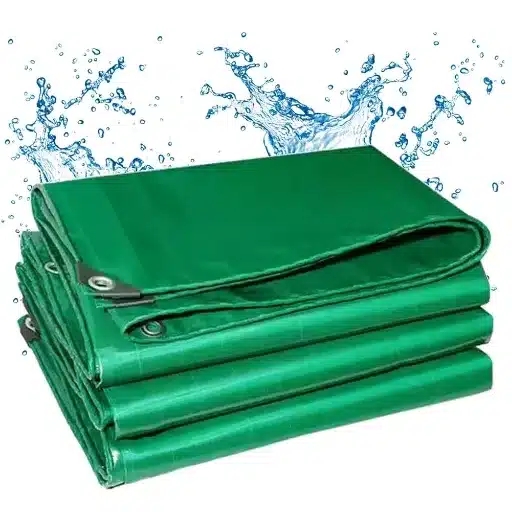
What is a Tarp?
Tarps, which is the short form for tarpaulin, are huge sheets consisting of strong, flexible, and water-resistant material, often coated with polyethylene, PVC, or canvas. While tarps provide shelter from the unkind elements of nature, their remedial applications are alien to neither the residential nor commercial spheres. A recent search ranking pointed that tarps are generally mostly searched when this might be needed: covering goods, sheltering machinery, and covers from moisture, dirt, or rays. Facilities such as reinforced edges and grommets are usually incorporated in the design to aid attachment and resolve any kind of outdoor problem that could require heavy-duty use. Particularly, industrial-grade tarps are built to withstand extreme weather, abrasion, and exposure to sunlight for a considerable period, thus ensuring their long-term durability and robust functionality.
Types of Tarps: Heavy Duty, Light-Duty, and More
Tarps come in many grades so that each can meet certain specifications depending on what exactly is required on the use case and environmental demand.
Heavy-Duty Tarps
- Material: Reinforced polyethylene or vinyl
- Thickness: 10-20 mils and above
- Durability: High-grade tensile strength
- Weather Resistance: Storms, heavy rain, snow, UV rays
- Applications: Construction sites, industrial equipment, temporary roofing
Light-Duty Tarps
- Material: Lighter polyethylene
- Thickness: 5-8 mils
- Portability: Easy to carry and manipulate
- Weather Resistance: Mild to moderate conditions
- Applications: Furniture protection, agricultural products, trailer covers
Specialized Tarps
- Mesh Tarps: Shading and debris containment with airflow
- Canvas Tarps: Breathable, water-resistant for machinery
- Fire Retardant: Safety compliance for industrial sites
- Eco-Friendly: Biodegradable and recyclable options
Market Trends: The latest data trends sourced from the search engine suggest that interest in heavy-duty tarps has surged, particularly in areas susceptible to severe weather incidences, stressing their utility and need in emergency preparedness and industrial projects. Search for green tarp options, such as biodegradable or recyclable materials, meanwhile, shows that consumers are becoming increasingly conscious of sustainability when searching for tarps.
Key Features of Commercial Tarps
Commercial tarps are constructed to answer the hardy needs of many applications-durable, versatile, and functional. Possibly, the key feature would be resistance to extreme weather, with the various materials employed, polyethylene, or PVC-coated fabrics, all offering excellent resistance to UV radiation, tearing, and penetration of water. A greater number of high-grade tarps are also reinforced with stitched grommets to securely fasten in place, aiding stability even under high wind loads. Fire retardant tarps are obtainable, as allowed by law, for places needing enhanced fire safety measures, such as construction sites, or industrial facilities.
Weather Resistance
Excellent UV radiation, tearing, and water penetration resistance
Reinforced Construction
Stitched grommets and reinforced edges for secure fastening
Fire Safety
Fire retardant options for enhanced safety compliance
Advanced Features
Breathable membranes and anti-mildew coatings
Innovation Focus: Latest insights from search data reveal an increasing preference for tarps incorporating advanced features like breathable membranes to avert moisture buildup and anti-mildew coatings for extended use in humid climates. At the same time, the rise in eco-friendly tarps reflects attention towards biodegradable and recyclable products from the current lenses of sustainability. These trends thus act as a pointer to consumer preference while aiding manufacturers in developing innovative tarp solutions of performance with environmental responsibility.
Material Types of Tarps
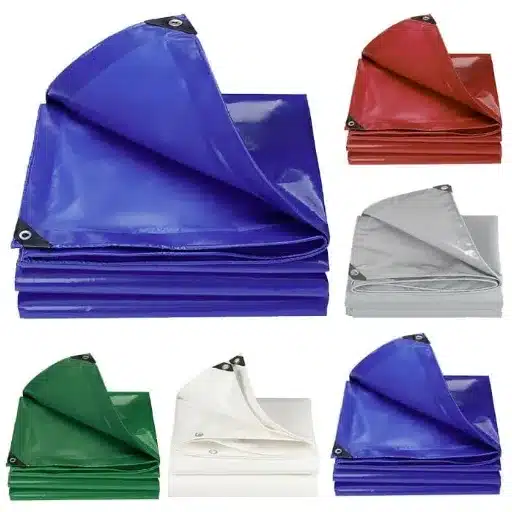
Poly Tarps: Versatility and Applications
These poly tarps, from the words polyethylene tarpaulins, have been very much in use throughout various industries over time for their versatility and economical nature. Constructed of woven polyethylene coated on both sides with a polyethylene layer, they offer a somewhat durable and lightweight option for various uses. Owing to search trends, users mostly inquire about the general uses of poly tarps and their advantages.
Common Applications of Poly Tarps
Temporary Shelters
Emergency roof protection after storms
Agricultural Protection
Crop and hay bale protection from rain
Outdoor Storage
UV-proof and waterproof covering
Recreational Use
Camping and event protection
Poly tarps are used for PCB protection, from temporary shelters to construction and agricultural covers. Give them a scenario where these tarps work immediately as a roof tarp to protect damaged buildings from extra rain or sun after the storm. From poly tarps, farmers want to protect their crops and hay bales from rain that may cause quality deterioration to spoilage. At the same time, poly tarps can be used for UV-proof and waterproof protection for outdoor storage and recreational uses such as camping and events. They are inexpensive, whereas they offer high tensile strength and are tear and mildew resistant, making them useful for both residential and commercial users.
Market Position: The poly tarps, therefore, continue to remain one of the most sought-after resources across many sectors, offering a viable performance-and-value combination for different user requirements.
Canvas Tarps: Durability for Industrial Use
Known for their unrivaled durability and dependability, canvas tarps find application in various industrial sectors. Made from heavy-duty, tightly woven cotton or polyester fabric, they offer superior resistance to abrasion, tearing, and extreme weather conditions. Canvas tarps are breathable, allowing moisture to escape, given that they prevent condensation build-up, a factor crucial in construction, agriculture, and manufacturing industries. Also treated for mildew and flame resistance, they comply with very high standards of safety for industrial application.
Key Advantages
- Superior abrasion and tear resistance
- Breathable fabric prevents condensation
- Mildew and flame resistance treatments
- Compliance with industrial safety standards
- Long-term durability in harsh conditions
Industry Applications
- Construction site protection
- Agricultural equipment covering
- Manufacturing facility use
- Heavy machinery protection
- Industrial containment solutions
Market Demand: Searching in the wake of the latest trends reveal a rise in queries related to “industrial tarps for heavy use” and “breathable tarps for large machinery,” showing the increase in demand for products such as canvas tarps. This is indicative of the fact that businesses are now actively looking forward to materials that provide both durability and functionality with emphasis on usage under harsh environments. Standably, canvas tarps are, therefore, the prerequisite asset in an industry requiring high-performance solutions for protection and containment.
Mesh Tarps: Breathability and Lightweight Options
Valued for ventilation and lightweight properties, mesh tarps work best in situations requiring airflow and negatives on weight. Search data from ‘s engine have shown surges in queries like “mesh tarps for shade” and “breathable tarps for construction,” proving the increasing relevance of these products in the marketplace. This increase in popularity is attributed to the unique construction of mesh tarps; they consist of tiny perforations that allow ventilation while offering partial protection from the sun. These features make mesh tarps best suited to cover outdoor structures, scaffolding, or agricultural objects where air circulation is a must to avoid heat buildup or moisture retention. Correspondingly, mesh tarps cover a broad spectrum of needs in construction, landscaping, and recreational industries, offering a lightweight yet durable solution.
Mesh Tarp Benefits & Applications
Key Benefits
- Excellent ventilation
- Lightweight and portable
- UV protection with airflow
- Cost-effective solution
- Easy installation and removal
Best Applications
- Construction scaffolding covers
- Agricultural shade structures
- Outdoor event canopies
- Landscaping protection
- Recreational area shading
Applications Across Various Industries
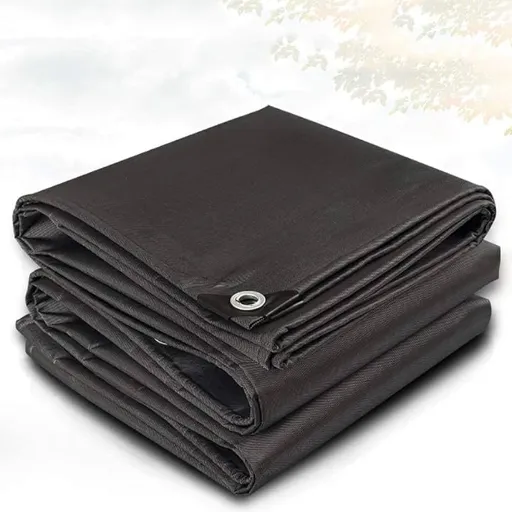
Truck Tarps: The Protection of Loads on the Road
Truck tarps are used to keep cargo safe during transportation so that loads are suspended from the effects of natural elements like winds, rains, and UV rays by supporting a strong force. Search engine data in recent times indicate a huge rise in trends of searches for “best truck tarps for weatherproofing” and “heavy-duty tarps for transport,” which means that there is more interest in some durable and utilitarian solutions. These tarps are made from high-strength options: usually polyethylene or vinyl, neither of which tear or abrade easily. Besides, new technological advancements have resulted in reinforced hems, waterproof coats, and grommets to secure tarps firmly from the ground-the latter being quite useful. Truck tarps are arguably a key component of the logistics industry, regardless of whether they are used to cover long-haul freight, agricultural loads, or construction materials, forming one of the necessary tools that usually protect load integrity from spillage and meet some safety norms.
| Feature | Benefit | Application |
|---|---|---|
| High-Strength Materials | Tear and abrasion resistance | Long-haul freight protection |
| Reinforced Hems | Enhanced structural integrity | Heavy cargo securing |
| Waterproof Coatings | Complete moisture protection | Weather-sensitive materials |
| Secure Grommets | Reliable fastening system | Safety compliance |
Field Tarps: Uses for Agriculture and Sports
Being durable, weather-resistant, and easily adaptable, field tarps find use in both agriculture and sports. In agriculture, their prime purpose is to protect crops, hay, and soil from the adverse effects of weather, such as rain, wind, and UV rays. Their waterproof and UV-resistant nature prevents waterlogging and erosion, thus maintaining soil quality and crop yield. Advanced field tarps might include breathable membranes to help manage moisture while inhibiting mold growth.
Agricultural Applications
- Crop protection from weather
- Hay and silage covering
- Soil erosion prevention
- Moisture management
- UV protection for sensitive plants
- Mold growth inhibition
Sports Applications
- Playing surface preservation
- Stadium field protection
- Turf damage prevention
- Quick deployment systems
- Weather-resistant materials
- Professional-grade standards
In sports, these tarps are critical in preserving playing surfaces, especially within stadiums or sport complexes. They shield the turf or synthetic fields from heavy downpours, which would otherwise result in damage and reduce available time for the fields to be deemed playable. The tarps are purposely designed to be swiftly deployed and removed, often using lightweight yet resilient material to assist in this process. According to the latest, interest in specialized sports tarps is on the upswing, with searches falling on “baseball field tarps” and “soccer field covers” quite frequently, underscoring their growing importance for maintaining professional grade field standards.
Innovation Trend: The introduction of innovative features such as reinforced edges and modular designs only increases their utility in both sectors. With the rise in demand for sustainable and durable protective solutions, these field tarps will remain at the forefront of agricultural and sprites needs.
Fire Retardant Tarps: Commercial Safety
In essence, fire retardant tarps are intended to suppress any potential fire hazard from developing during commercial operations. Constructed of silicone-coated fiberglass, vinyl, or polyethene treated with flame-resistant chemicals to meet stringent safety standards such as NFPA 701 and CPAI-84, these tarps are used widely across industries, especially construction, manufacturing, and warehousing, where they act as slump guards, welding curtains, or temporary enclosures.
Fire Retardant Tarp Specifications
Materials
- Silicone-coated fiberglass
- Treated vinyl
- Flame-resistant polyethylene
Safety Standards
- NFPA 701 compliance
- CPAI-84 certification
- Industry-specific ratings
Applications
- Welding curtains
- Safety barriers
- Temporary enclosures
Industries
- Construction
- Manufacturing
- Warehousing
Market Demand: From the latest data, the demand for fire-retardant tarps has witnessed a constant rise, the searches now being categorized under “industrial fire protection solutions” and “flame-resistant tarp compliance standards.” This indicates that there is increasing awareness among commercial operators of industrial fire risk mitigation within their operational premises. The fire-retardant tarp thus combines durability, resistance to weather, and certified fire protection, which makes it an indispensable tool for keeping work environments safe and legally-compliant.
Choosing the Right Tarp for Your Needs
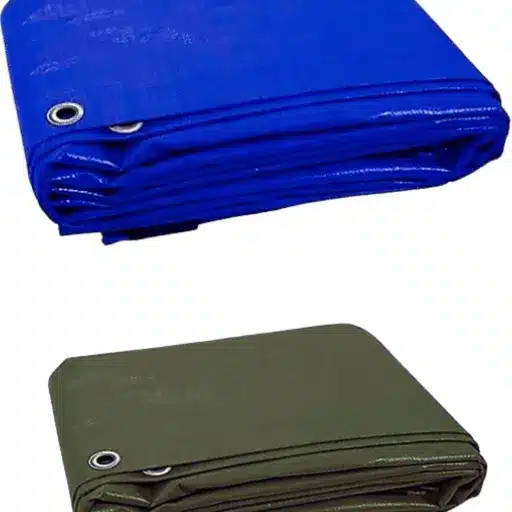
Considerations for Durability and Weather Resistance
Durability and weather resistance are selected in tarps for long-term performance and safety. Durability, consisting of tensile strength, density, and wearing off due to stressors from the environment, is dependent on the material. The most robust tarps come from HDPE and vinyl coating, giving them great resistance from tearing and puncturing.
Durability Factors
- Tensile Strength: Resistance to stretching and breaking
- Material Density: Thickness and weave quality
- Environmental Stress Resistance: Ability to withstand harsh conditions
- HDPE and Vinyl Coatings: Superior tear and puncture resistance
Weather Resistance Features
- UV Protection: Coatings prevent degradation from sunlight
- Temperature Resistance: Performance in extreme conditions
- Waterproof Membranes: Complete moisture protection
- Reinforced Edges: Prevention of wind damage and tears
Weather resistance is important in the protection of equipment and environments from extreme changes in temperature, solar radiations, and precipitation. Modern fire-retardant tarps usually include coatings that prevent degradation from UV exposure to ensure longevity even when exposed to sunlight for several hours. Such materials are also designed to keep their form under heavy rains and winds through the arrangements of waterproof membranes and reinforced edges, minimizing their susceptibility to leaks or damages.
Selection Criteria: Search engine analytics data for recent times show an upward trend regarding extreme condition tarps-for-hurricane-stricken areas or industrial storage requiring temperature-regulating covers. In the alternative evaluation process, one should consider how the working environment exposes it to harsh conditions and the regularity of such exposure. It should also take into consideration the respective compliance standards of the industry.
Custom-Made to Specific Applications
When designing tarps for specific applications, it is critical to integrate advanced material technology and emerging user preference. According to fresh records from search engine analytics, demand is very strong for customization in the realm of durability and specific functions. Typical functionalities requested included dyes and coatings against UV for long-term sun exposure, flame retardants for industrial/safety environments, and layers of insulation for temperature control in extreme climate conditions. Other features that are custom requested are grommet placement or reinforced edges for their own special mounting or fastening requirements. Through the incorporation of custom features, tarps will meet the rigorous operational needs of their users while simultaneously fulfilling user-demanded attributes, which guarantee optimum performance and compliance with relevant standards.
Custom Features in High Demand
UV Protection
Specialized coatings for long-term sun exposure
Flame Retardants
Industrial safety and compliance requirements
Insulation Layers
Temperature control in extreme climates
Custom Grommets
Specialized mounting and fastening systems
Cost-Effectiveness and Longevity Analysis
When we look at tarps for their cost-effectiveness, we must look into durability and material composition and resistance to environment. The latest innovations in manufacturing involve weaving in polypropylene in very high densities, and polyester covered in vinyl. These greatly enhance the life of the products so that the frequency of replacement is decreased as well as its maintenance. A trend highlighted by recent data shows a steady increase in consumer interest in heavy-duty, UV-resistant tarps, depicting a preference for products that work well in harsh conditions while keeping away long-term expenses.
| Factor | Impact on Cost-Effectiveness | Long-term Benefits |
|---|---|---|
| Material Quality | Higher upfront cost, lower replacement frequency | Reduced total ownership cost |
| UV Resistance | Extended lifespan in harsh conditions | Consistent performance over time |
| Proper Usage | Prevents premature wear and damage | Maximizes investment value |
| Storage Practices | Maintains material integrity | Extends operational lifespan |
The usage and storage of tarps also largely affect their longevity. Taking care to remove any debris from tarps, storing them dry, and having them used within the recommended limits of stress would prevent premature wear. Comparative studies show that high-end tarps with features such as tear-resistant fibers and heat-sealed seams will save money in the long run despite a hefty initial investment. This trade-off between the price paid upfront and the utility it has going forward really puts into consideration that high-grade tarps are the economical option for personal and commercial use.
Maintaining Your Commercial Tarps
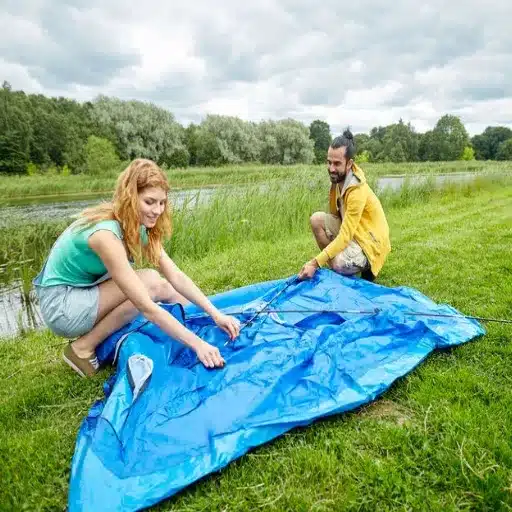
Tips for Proper Care and Maintenance
For commercial tarps to survive their intended purpose for a long time, they need offer proper attention and cleaning. Research has shown that regular maintenance on these materials greatly lowers the rate of their degradation and hence tarp usability. First, remove any loose debris using a soft brush or a soft cloth to prevent any surface damage. Mild soap with lukewarm water for cleaning is best since harsh chemicals can degrade the tarp’s material, especially on tarps treated with UV-resistant coatings. After washing, allow the tarp to dry in a shaded area to reduce the probability of heat stress being built on the fibers as a consequence of direct exposure to sunlight. Also, it is important to inspect the tarp regularly. Check for signs of wear; little tears, broken down edges to mention, just a few. Minor repairs need to be carried out immediately using repair kits so that they do not worsen. According to current search trends, many users ask questions about how proper storage really matters. Therefore, tarps should always be folded and stored away in clean, relatively dry locations free from insects and pest attacks to prevent wear. By combining the above care methods with regular inspections, the entire cost of keeping tarps becomes economical and increases their operational period.
1
Debris Removal
Remove any loose debris using a soft brush or cloth to prevent surface damage and maintain material integrity.
2
Gentle Cleaning
Use mild soap with lukewarm water. Avoid harsh chemicals that can degrade UV-resistant coatings and protective treatments.
3
Proper Drying
Allow tarps to dry in shaded areas to prevent heat stress on fibers from direct sunlight exposure.
4
Regular Inspection
Check for wear signs, tears, and edge degradation. Perform immediate minor repairs to prevent worsening damage.
5
Proper Storage
Store in clean, dry locations free from insects and pests. Proper folding prevents unnecessary wear and extends lifespan.
Storage Techniques to Increase the Life of Tarps
Proper storage forms a critical link to ensuring the continued functionality and lifespan of tarps. Users are found to be doing some searching concerning the ideal environmental condition for storing tarps, based on recent search data. In answer to their searches, the tarp must always be stored in a cool, dry place; tarps must never go under direct UV rays. Prolonged UV rays exposure can weaken the tarp material to the extent that the material diverts into brittleness or fading. Furthermore, keep the storage area clean from moisture, as excess moisture may promote the growth of molds and mildews, especially for those tarp fabrics that are non-breathable, like polyethylene or vinyl. Folding the tarp properly without forming uncivil sharp creases will prevent stress points, and storing it in a container resistant to pest intrusions will provide another layer of protection. Following these best practices will help to minimize the damage and, thereby, optimize the performance of your tarps over time.
Essential Storage Guidelines
Environmental Control
- Cool, dry storage areas
- No direct UV exposure
- Moisture-free environment
Folding Techniques
- Avoid sharp creases
- Prevent stress points
- Proper folding patterns
Pest Protection
- Pest-resistant containers
- Clean storage areas
- Regular inspection
Material Considerations
- Polyethylene care
- Vinyl protection
- Canvas storage needs
Identifying and Repairing Common Problems
Tarp maintenance brings about some common issues such as fabric tearing, puncturing, weakening of grommets, and so on. Tears could have emerged from being exposed to down drafts for long or from being cut by sharp objects. To mend small and medium-sized tears, an adhesive patch for tarps of either vinyl or polyethylene is preferred; one of the best patches available out there for usage. Cleaning and drying the affected area is a must before applying the patch for best adhesion. Bigger tears, however, might include sewing the edges with heavy-duty thread, then sealing over the stitch line with waterproof adhesive to reinforce it.
Common Problems
- Fabric tearing from wind exposure
- Punctures from sharp objects
- Grommet weakening or failure
- Edge degradation over time
- UV damage and fading
Repair Solutions
- Adhesive patches for small tears
- Heavy-duty thread for large damage
- Waterproof adhesive sealing
- Grommet replacement kits
- Professional repair services
Punctures, typically caused by mishandling or debris falling onto the tarp, can compromise a tarp’s structural integrity. For these kinds of damages, repair kits with adhesive backs and patches of heavy-duty material will restore the function of the tarp. A very weak or missing grommet can cause much havoc, especially when the tarp is placed under tension. One could fix these by installing replacement grommets; a grommet installation kit usually consists of a hole punch and hammer-style setting tools to get the best fit.
Professional Approach: Continuous inspection and rapid repairs help in increasing tarp life. Drawing from the latest insights from search data, the prominence of keywords like “high-strength tarp repair kits” and “waterproof adhesive solutions” also show us what users find most important when dealing with such problems, reaffirming an industry standard focus on materials that stand repair work durable and resistant to water for a steadfast period. It is possible for these organized approaches to make functionality and cost-efficiency adorably manageable and sustainable.
Essential Tarp Accessories
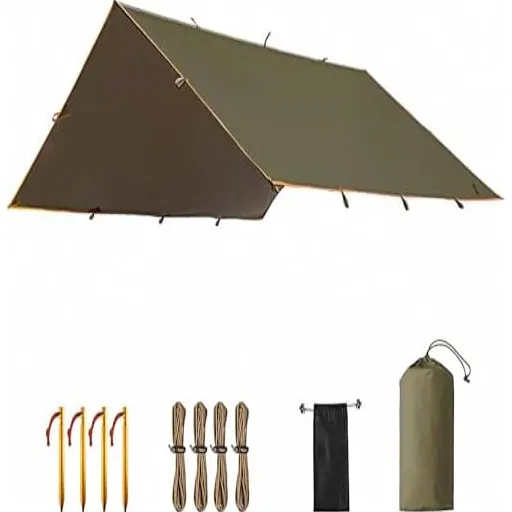
Grommets and Tie-Downs: For Secure Usage
Grommets and tie-downs are integral parts that provide the secure use of tarps especially, against inclement weather or heavy usage conditions. According to a recent round of searches, search queries pertaining to “heavy-duty grommets” and “adjustable tarp tie-downs” have been on the rise, hence revealing a clear user preference towards enhancing stability and longevity of these accessories. In laymen’s terms, these are fastening mechanisms that help an individual anchor his or her tarp firmly to keep the wind from wreaking havoc on it or from displacing it. When combined with reinforced edges and materials rated for tensile strength, grommets and tie-downs demonstrate functionality and longevity of the tarp, which finds application both in the household and industrial areas.
Grommets
- Heavy-duty brass or stainless steel
- Strong anchor points for tensioning
- Reduced stress on tarp material
- Professional installation options
- Various sizes for different applications
Tie-Downs
- Adjustable tensioning systems
- Wind resistance capabilities
- Secure anchor mechanisms
- Industrial and household applications
- Enhanced stability and longevity
Custom Tarp Solutions: Improving Functionality
Data collected from ‘s search engine indicates that there is an inclination for custom tarp solutions to address the specific needs of users. Queries such as “custom-sized tarps,” “UV-resistant tarps,” and “insulated tarps for extreme weather” affirm the demand for more versatile designs rather than having to work with those that are standard. By incorporating the latest engineering techniques of heat-sealed seams, heavy-duty polymer coatings, and customized dimensions, manufacturers thus meet marketplace requirements extending from agricultural solutions to industrial use. Hence, when the option of fire resistance or antimicrobial properties is presented, the added functional value meets regulatory requirements and user needs simultaneously. These improvements, supported by current search trends, indicate the importance of tarp solutions adapted to meet the evolving consumer agenda.
Popular Custom Solutions
Engineering Features
- Heat-sealed seams
- Heavy-duty polymer coatings
- Customized dimensions
Special Properties
- Fire resistance
- Antimicrobial treatments
- Extreme weather insulation
Market Applications
- Agricultural solutions
- Industrial use
- Regulatory compliance
Cutting-Edge Accessories
Accessories that promote durability are very important in increasing the life span of tarps, especially in some harsh environments. Popular accessories include grommets, reinforced corner patches, and bungee cords, according to the search data. Grommets, which are mostly made of brass or stainless steel, act as strong anchor points and reduce the stress on tarp material while tensioning is taking place. Reinforced corner patches strengthen the big points of stress, preventing tearing and therefore prolonging product usability. Bungee cords, often with UV-resistant coatings, provide adjustable and reliable fastening systems for various applications. Tarp tape and edge reinforcement are among the frequently searched accessories, indicating their relevance in combatting tearing and exposure. Taken together, these accessories, when selected wisely, greatly contribute to improving tarp longevity and serviceability, thus ensuring that they remain relevant in today’s world.
Grommets
Brass/stainless steel anchor points reducing material stress
Corner Patches
Reinforcement for high-stress areas preventing tears
Bungee Cords
UV-resistant adjustable fastening systems
Tarp Tape
Edge reinforcement for tear and exposure protection
Frequently Asked Questions
What are the uses of heavy duty tarps for commercial applications?
Since heavy duty tarps provide excellent durability due to the fact that they are made for design-for-tough conditions, commercial use can be set for them. They are made on some really high-quality material such as heavy industrial vinyl or polyethylene so that they can brave adverse weather conditions. Depending on application, they are offered in all sorts of sizes and thicknesses (12 mil plus), which maybe some cover works, equipment covering, material protection, or temporary shelter. Furthermore, heavy duty tarps are usually waterproof, so they will protect your items from getting soaked during rain showers. The least a tarp can do is exist longer and protect an excellent price for any business that requires such a tarp for regular poor performance.
Can a custom tarp really carry on my business operations?
Custom tarps provide significant business process enhancements by offering specific solutions. Custom tarps make sure the best possible fit, whether you want to cover something unique or you need a specific size to fit your equipment. This could come in handy, especially in areas such as construction, where construction fabrics may need to provide protection for materials from an inclement environment. Besides, your custom tarps can go through suitable customizations like grommets for easy installation of custom tarps or reinforcing the edges for durability. By enhancing efficiency and keeping their assets protected, custom tarps definitely contribute to the success of any business.
What are the different material options available for industrial tarps?
Talking of industrial tarps, there exist several material types to meet differing needs. Poly tarps are commonly used due to their cost efficiency and versatility and have multiple usages-from covering woodpiles to serving as temporary shelters. On the contrary, canvas tarps are considered more durable and are usually employed wherever a heavy-duty alternative would be needed. Vinyl tarps also allow the option of being waterproof and thus present the finest defense against water and moisture with outdoor uses in mind. Mesh tarps bestow shade and some protection while allowing air to pass through, which proves beneficial for agricultural applications such as hay tarps. Each choose brings distinct advantages and these would allow the business to opt for the best one according to its needs.
What industries best utilize vector tarps?
Mesh tarps provide numerous solutions for nearly all sorts of purposes. In agriculture, for instance, they can be used for covering hay or protecting crops from the sun while allowing air circulation. They are also appropriate for construction sites – they shade and protect workers without blocking airflow. Likewise, mesh tarps can be used for trucks, securing the transport of materials while preventing debris from escaping. Lightweight and durable, they are easy to manage and come in various sizes to suit all needs. In short, mesh tarps offer one diversified solution that protects without compromising ventilation.
Is there a fire-retarding commercial tarp?
Indeed there are fire-retardant options for commercial tarps, which are very important in industries where fire safety is considered. Fire-retardant tarps help resist the spread of flame as they are chemically treated-and are suitable for construction projects, outdoor events, or scenarios where fire hazards may present. These tarps are frequently constructed using heavy-duty materials, meaning they also retain durability and weatherproofing aside from fire retardance. However, ensure that these fire-retardant tarps comply with any safety standards relevant to your particular industry when selecting them. This extra measure of security can offer peace of mind in addition to safeguarding your assets and personnel.
How many different sizes are there for commercial tarps?
Commercial tarps are produced in many sizes to cater to various needs and applications. From tarps small enough to cover equipment to huge tarps that would be used on construction sites, there are many options. Many suppliers offer their tarps in standard sizes; however, it is also possible to order custom-made tarps to fit the exact dimensions required for a project. Sizes vary from light-duty poly tarps meant for quick covers to super heavy-duty tarps intended for industrial strength applications. When selecting a tarp, the size should not only be considered but also the thickness, because the mil thickness will determine the tarp’s durability and the best application it is suited for. With such a variety of different sizes being available, businesses can find the perfect tarp for their needs.
Reference Sources
University of Maine – Tarping in the Northeast: Types of Tarps and How They Work
This publication provides insights into different types of tarps, their materials, sizes, and applications, focusing on their permeability, cost, and longevity.
University of Massachusetts – Tarping for Vegetable Crops
This fact sheet discusses the use of tarps in agriculture, particularly for vegetable crops, highlighting their thickness, reusability, and effectiveness.

